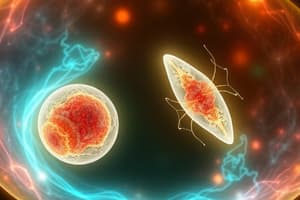Podcast
Questions and Answers
What is the primary function of mitosis?
What is the primary function of mitosis?
- Production of sex cells
- Genetic diversity through sexual reproduction
- Reduction of chromosome number by half
- Cellular reproduction and general growth and repair of the body (correct)
What is the end result of meiosis?
What is the end result of meiosis?
- Two diploid cells
- Two haploid cells
- Four haploid cells (correct)
- Four diploid cells
In which type of organisms does meiosis occur?
In which type of organisms does meiosis occur?
- Sexually reproducing organisms (correct)
- Neither asexually nor sexually reproducing organisms
- Both asexually and sexually reproducing organisms
- Asexually reproducing organisms
What is the number of cell divisions in meiosis?
What is the number of cell divisions in meiosis?
What is the purpose of meiosis?
What is the purpose of meiosis?
What happens to the chromosome number during meiosis?
What happens to the chromosome number during meiosis?
What is the main difference in the number of chromosomes between mitosis and meiosis?
What is the main difference in the number of chromosomes between mitosis and meiosis?
In which type of cells does mitosis occur?
In which type of cells does mitosis occur?
What is the result of the reduction in chromosome number during meiosis?
What is the result of the reduction in chromosome number during meiosis?
How many daughter cells are produced in meiosis?
How many daughter cells are produced in meiosis?
What is the main distinction between the stages of mitosis and meiosis?
What is the main distinction between the stages of mitosis and meiosis?
What is the primary function of mitosis in multicellular organisms?
What is the primary function of mitosis in multicellular organisms?
Flashcards
Cell Division
Cell Division
Cell division producing new cells.
Mitosis
Mitosis
Asexual reproduction creating identical diploid cells.
Meiosis
Meiosis
Cellular reproduction that halves chromosomes, creating haploid cells.
Mitosis Cell Type
Mitosis Cell Type
Signup and view all the flashcards
Meiosis Cell Type
Meiosis Cell Type
Signup and view all the flashcards
Mitosis Function
Mitosis Function
Signup and view all the flashcards
Meiosis Function
Meiosis Function
Signup and view all the flashcards
Mitosis Output
Mitosis Output
Signup and view all the flashcards
Meiosis Output
Meiosis Output
Signup and view all the flashcards
Mitosis Chromosome Number
Mitosis Chromosome Number
Signup and view all the flashcards
Meiosis Chromosome Number
Meiosis Chromosome Number
Signup and view all the flashcards
Mitosis Phases
Mitosis Phases
Signup and view all the flashcards
Study Notes
Shared Characteristics of Mitosis and Meiosis
- Both produce new cells
- Both require a parent cell
- Both follow the same steps for cell division: prophase, metaphase, anaphase, telophase
- Both involve the duplication of chromosomes
- Both involve the breakdown of the nuclear membrane
Mitosis
- A process of asexual reproduction that produces a replica with an equal number of chromosomes in each resulting diploid cell
- Creates normal body cells (everything other than sex cells)
- Occurs in both sexually and asexually reproducing organisms
- Function: cellular reproduction and general growth and repair of the body
- Genetically: identical
- Produces 2 diploid cells
- Chromosome number: remains the same
- Number of divisions: 1 cell division
- Stages: prophase, metaphase, anaphase, telophase
Meiosis
- A type of cellular reproduction that reduces the number of chromosomes by half, producing two haploid cells
- Creates sex cells only: female egg cells or male sperm cells
- Occurs in sexually reproducing organisms only
- Function: genetic diversity through sexual reproduction
- Genetically: different
- Produces 4 haploid cells
- Chromosome number: reduced by half
- Number of divisions: 2 cell divisions (meiosis 1 and meiosis 2)
- Stages: prophase I, metaphase I, anaphase I, telophase I; prophase II, metaphase II, anaphase II, and telophase II
Mitosis vs Meiosis
Definition and Purpose
- Mitosis: a process of asexual reproduction, resulting in two diploid cells with an equal number of chromosomes.
- Meiosis: a type of cellular reproduction, reducing the number of chromosomes by half, producing two haploid cells.
Cell Types and Occurrence
- Mitosis: creates normal body cells (except sex cells), occurs in both sexually and asexually reproducing organisms.
- Meiosis: creates sex cells only (female egg cells or male sperm cells), occurs in sexually reproducing organisms only.
Function and Genetic Diversity
- Mitosis: cellular reproduction, general growth, and repair of the body, producing identical cells.
- Meiosis: genetic diversity through sexual reproduction, producing different cells.
Cell Division and Chromosome Number
- Mitosis: 2 diploid cells produced, chromosome number remains the same, one cell division.
- Meiosis: 4 haploid cells produced, chromosome number reduced by half, two cell divisions (Meiosis 1 and Meiosis 2).
Stages of Cell Division
- Mitosis: Prophase, Metaphase, Anaphase, Telophase.
- Meiosis:
- Meiosis 1: Prophase I, Metaphase I, Anaphase I, Telophase I.
- Meiosis 2: Prophase II, Metaphase II, Anaphase II, Telophase II.
Studying That Suits You
Use AI to generate personalized quizzes and flashcards to suit your learning preferences.





